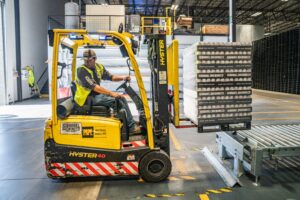Health and safety is carefully considered across many sectors, and regardless of the type of work being undertaken, all employees should expect that their employers provide a safe and protected environment. In this piece, Tata Communications’ Alok Bardiya, Head – Internet of Things (Business Unit), explains how IoT technology can help protect workers in hazardous environments.
For all the disruption and suffering caused by the pandemic, one silver lining has been the closer emphasis on employee health and keeping people safe in the workplace.
In a bid to support newly minted remote workers in the face of sudden office closures, many businesses started offering employees access to mental wellbeing services and flexible work hours. This helped workers carry on effectively while they took on new roles, such as teacher or carer. 
A lot of these flexible working initiatives were programs employees had desired for years. As a result, this moment is being seen by many as the start of a revolution in employee wellbeing.
And while this is good news, so far this transformation has been mostly reserved for white-collar workers. But for millions of industrial workers around the world, ‘remote working’ has always been a distant reality.
“For factory workers, building site contractors, and transport staff, remote working rarely involves sitting at home in front of a laptop. Instead, it can mean being physically distributed across large geographic areas, often alone and in potentially hazardous environments.”
These workers also deserve their own health and safety revolution – especially as the majority of the 2.78 million work related fatalities recorded each year are in this group. So in this piece, I will discuss why addressing health and safety concerns is not only the right thing for employers to do, but the fiscally responsible one too. IoT may just be the key to unlocking this revolution.
The true cost of health and safety
Worker health and safety has been a concern since the start of the industrial age. The first worker strike in India in 1862 was, among other things, due to complaints of excessive workloads. But over the decades, regulations and policies have slowly been introduced to ensure the safety of factory workers.
Nonetheless, there are 374 million work related injuries each year. Because, while regulations are great at preventing certain health and safety concerns, they often can’t protect against the more fluid nature of threats in industrial workplaces.
For example, in remote areas with poor connectivity, companies may struggle to inform their people of incidents that call for site evacuations. This challenge and threat grows exponentially when you consider a workplace that’s dozens of feet underground or in the middle of an ocean. 
And the prevalence of the problem doesn’t make it any less costly to businesses. Each year, poor occupational health and safety reduces global GDP by 3.94%.
So, while it’s in every business’ interest to provide employees with the best health and safety protection they can, up until now, there’s been relatively few dynamic and cost-effective industrial strength, integrated, health and safety solutions.
But with new advancements in industrial IoT, that’s all changing.
A secure and connected workplace
Developments in the Internet of Things (IoT) now allow for any workplace, regardless of size and scope, to connect, monitor and protect employees. What’s more, the data IoT generates can help drive insights that enhance productivity across the whole of organisation.
IoT is cost-effective to deploy and maintain, while offering unparalleled levels of granularity when it comes to monitoring and controlling an environment. Sensors installed across locations can also enable pre-emptive intervention in case of accidents and emergencies. This makes it the ideal choice for any industrial work environment.
“Leaders in charge of health and safety can reduce the impact of incidents, while ensuring compliance with regulatory requirements. Auditors can even access digital records when validating compliance, as opposed to working their way through cumbersome paper records.”
Operations leaders, on the other hand, can monitor work to ensure maximum production and productivity uptime in employees.
And that’s before considering the monumental impact on mental wellbeing these measures will have on workers. With concrete reassurances these technologies offer, employees will feel more valued and protected – an important trait for anyone works in a hazardous environment.
Health and safety is an investment – not a cost
Research has shown that every dollar invested in health and safety returns a 500% payback to the organisation. And with a solution as dynamic as IoT, a myriad of highly specific situations can be catered for.
Tata Communications’ Worker Safety and Efficiency Solutions are on the cutting edge of this digital revolution, combining wearable tech with IoT, analytics and AI to securely support industrial workers. The portfolio spans an entire range of smart devices – from a ‘smart watch’ to SafePass to smartphone app based solutions. All of these leverage the smart IoT Fabric that Tata Communications is providing to its enterprise customers for their Connected Operations.
“Features like access management track employees’ entry and exit to facilities and ensures only authorised workers have access to certain areas.”
With appropriate additional sensors, it can also be used in environmental monitoring to detect the harmful emission of gases such as CO2 and NO2, notifying workers within range. 
And with wearable tech such as smartwatches, other features such as headcount capture, SOS alerts and vital signs tracking are all possible too.
So, let us all – white-collar and industrial workers alike – move into the next normal together, by ensuring the post-pandemic workplace of the future is a safe space for all.
To find out more about how IoT is revolutionising work and our lives, check out our blog: Connecting generations: The growing role of IoT in elderly care.
Transformational Hybrid SolutionsOur cloud-enablement services offer the best performance on your traffic-heavy websites or mission-critical applications.
Core NetworksTata Communications™ global IT infrastructure and fibre network delivers the resources you need, when and where you need them.
Network Resources
Unified Communications As A ServiceBreak the barriers of borders efficiently and increase productivity with Tata Communications’ UC&C solutions.
Global SIP ConnectEmpower your business with our SIP network and witness it grow exponentially.
InstaCC™ - Contact Centre As A ServiceCloud contact centre solutions for digital customers experience and agent productivity.
DIGO – Communications Platform as a ServiceDIGO is an in-network cloud communications platform, enabling you to power up converged contextual human-to-everything conversations globally.
Unified Communication Resources Case studies, industry papers and other interesting content to help you explore our unified communications solution better.
IoT SolutionsThe Internet of Things is transforming the way we experience the world around us for good. Find out more about our Internet Of Things related solutions here.
Mobility SolutionsTata Communications’ mobility services enable your enterprise to maintain seamless communication across borders, with complete visibility of cost and usage.
Mobility & IoT Resources
Multi-Cloud SolutionsWith enterprises transitioning to a hybrid multi-cloud infrastructure, getting the right deployment model that yields ROI can be a daunting task.
Cloud ComplianceCompliant with data privacy standards across different countries and is also designed to protect customers’ privacy at all levels.
IZO™ Cloud Platform & ServicesIZO™ is a flexible, one-stop cloud enablement platform designed to help you navigate complexity for more agile business performance.
Managed Infrastructure ServicesIntegrated with our integrated Tier-1 network to help your business grow efficiently across borders.
Cloud PartnersWe support a global ecosystem for seamless, secure connectivity to multiple solutions through a single provider.
Cloud Resources
Governance, Risk, and ComplianceRisk and Threat management services to reduce security thefts across your business and improve overall efficiencies and costs.
Cloud SecurityBest-in-class security by our global secure web gateway helps provide visibility and control of users inside and outside the office.
Threat Management - SOCIndustry-leading threat-management service to minimise risk, with an efficient global solution against emerging security breaches and attacks.
Advanced Network SecurityManaged security services for a predictive and proactive range of solutions, driving visibility and context to prevent attacks.
Cyber Security ResourcesCase studies, industry papers and other interesting content to help you explore our securtiy solution better.
Hosted & Managed ServicesTata Communications provide new models for efficient wholesale carrier voice service management. With our managed hosting services make your voice business more efficient and better protected
Wholesale Voice Transport & Termination ServicesYour long-distance international voice traffic is in good hands. End-to-end, voice access & carrier services which includes voice transport and termination with a trusted, global partner.
Voice Access ServicesTata Communication’s provide solutions which take care of your carrier & voice services, from conferencing to call centre or business support applications.
Carrier Services Resources
CDN Acceleration ServicesOur CDN Web Site Acceleration (WSA) solution helps deliver static and dynamic content, guaranteeing higher performance for your website.
CDN SecuritySafeguard your website data and customers’ information by securing your website from hacks and other mala fide cyber activities.
Video CDNDeliver high-quality video content to your customers across platforms – website, app and OTT delivery.
CDN Resources
Elevate CXIncrease customer satisfaction while empowering your service team to deliver world-class customer experience and engagement.
Live Event ServicesTata Communications’ live event services help battle the share if eyeballs as on-demand video drives an explosion of diverse content available on tap for a global audience.
Media Cloud Infrastructure ServicesTata Communications’ media cloud infrastructure offers flexible storage & compute services to build custom media applications.
Global Media NetworkTata Communications’ global media network combines our expertise as a global tier-1 connectivity provider with our end-to-end media ecosystem.
Use CasesUse cases of Tata Communications’ Media Entertainment Services
Remote Production SolutionsMedia contribution, preparation and distribution are highly capital-intensive for producers of live TV and video content, and their workflows are complex.
Media Cloud Ecosystem SolutionsThe Tata Communications media cloud infrastructure services offer the basic building blocks for a cloud infrastructure-as-a-service.
Global Contribution & Distribution SolutionsTata Communications’ global contribution and distribution solution is built to reduce capital outlay and grow global footprint.
Satellite Alternative SolutionsAs more and more consumers choose to cut the cord & switch to internet-based entertainment options, broadcasters are faced with capital allocation decisions.
LeadershipA look into the pillars of Tata communications who carry the torch and are living embodiment of Tata’s values and ethos.
Culture & DiversityHere at Tata Communications we are committed to creating a culture of openness, curiosity and learning. We also believe in driving an extra mile to recognize new talent and cultivate skills.
OfficesA list of Tata Communications office locations worldwide.
SustainabilityTata Communications adopts a holistic approach and harnesses the power of new-age technologies like 5G, IoT and AI to build a sustainable digital world.
FAQCheck out our FAQs section for more information.
BoardHave a look at our board of members.
ResultsFind out more about our quarterly results.
Investor PresentationsFollow our repository of investor presentations.
FilingsGet all information regarding filings of Tata communications in one place.
Investor EventsAll investor related event schedule and information at one place.
GovernanceAt Tata, we believe in following our corporate social responsibility which is why we have set up a team for corporate governance.
SharesGet a better understanding of our shares, dividends etc.
SupportGet all investor related contact information here.


